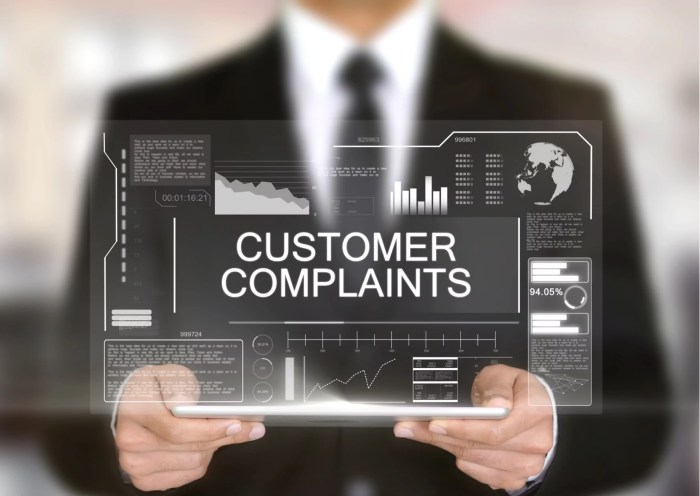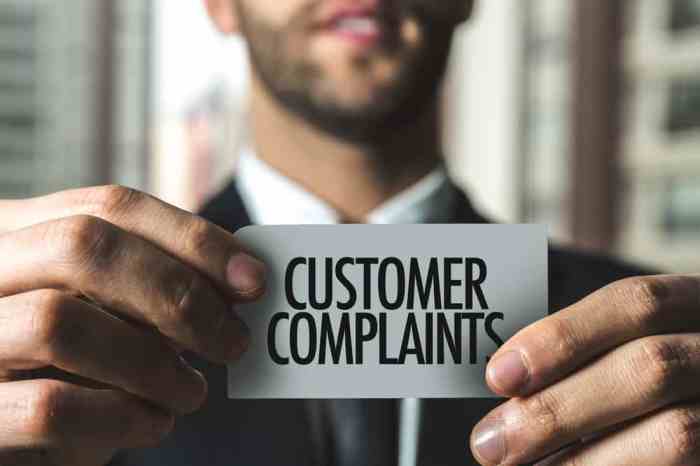Managing Customer Complaints takes center stage as businesses navigate the intricate world of customer satisfaction, offering a glimpse into the art of resolving issues with style and finesse.
In today’s fast-paced market, understanding the nuances of customer complaints and implementing strategic solutions is key to maintaining a loyal customer base and driving business success.
Understanding Customer Complaints

Customer complaints are expressions of dissatisfaction from customers regarding a product or service provided by a business. These complaints can range from issues with the product quality to problems with customer service interactions.It is essential for businesses to effectively manage customer complaints because it directly impacts customer satisfaction and loyalty. By addressing complaints promptly and efficiently, businesses can improve customer retention and prevent negative word-of-mouth publicity.
Common Types of Customer Complaints
- Product Quality: Customers may complain about receiving defective or substandard products.
- Customer Service: Complaints about rude or unhelpful customer service representatives are common.
- Billing Issues: Customers often complain about incorrect charges on their bills.
- Delivery Problems: Late or damaged deliveries can result in customer complaints.
- Communication: Lack of communication or misleading information can lead to customer dissatisfaction.
Importance of Managing Customer Complaints
In today’s competitive business landscape, managing customer complaints effectively is crucial for the success and sustainability of any company. Failure to address customer complaints can have detrimental effects on a business, ranging from loss of revenue to damage to reputation.
Impact of Unresolved Customer Complaints
Unresolved customer complaints can lead to a variety of negative consequences for a business. Customers who feel ignored or unimportant are likely to take their business elsewhere, resulting in lost sales and decreased revenue. Additionally, unresolved complaints can damage a company’s reputation, leading to negative word-of-mouth and a tarnished brand image.
Handling Complaints Well vs. Poorly
The way a business handles customer complaints can make a significant difference in customer loyalty. When complaints are addressed promptly and effectively, customers are more likely to feel valued and appreciated. This can lead to increased loyalty, repeat business, and positive recommendations to others. On the other hand, mishandling complaints or ignoring them altogether can result in dissatisfied customers who are unlikely to return and may even share their negative experiences with others.
Correlation between Complaint Management and Business Success
Statistics and case studies have shown a clear correlation between effective complaint management and business success. According to research, businesses that prioritize customer service and actively address complaints experience higher customer retention rates and increased profitability. In fact, a study by Harvard Business Review found that increasing customer retention rates by just 5% can lead to a 25-95% increase in profits.
Strategies for Handling Customer Complaints: Managing Customer Complaints

Effective management of customer complaints is crucial for maintaining customer satisfaction and loyalty. Here are some key strategies to handle customer complaints efficiently:
Step-by-Step Process for Managing Customer Complaints
- Listen to the customer’s complaint without interruptions.
- Acknowledge the issue and apologize for any inconvenience caused.
- Empathize with the customer to show understanding and concern.
- Offer a solution or alternatives to resolve the complaint effectively.
- Follow up with the customer to ensure their satisfaction with the resolution.
Tips for De-Escalating Tense Situations
- Remain calm and composed, even if the customer is upset or angry.
- Show empathy and understanding towards the customer’s emotions.
- Avoid taking the complaint personally and focus on finding a solution.
- Use positive language and assure the customer that their concerns are being addressed.
Significance of Active Listening
Active listening plays a crucial role in addressing customer complaints effectively. By actively listening to the customer’s concerns, you show respect and empathy towards their situation. It also helps in understanding the root cause of the complaint, allowing you to provide a suitable solution. Remember, sometimes customers just want to feel heard and valued, so active listening can go a long way in diffusing tense situations and resolving complaints satisfactorily.
Implementing Customer Feedback
Implementing customer feedback is crucial for businesses looking to improve their complaint management processes. By actively collecting and analyzing feedback from customers, companies can gain valuable insights into areas that need improvement and make necessary changes to prevent future complaints.
Methods for Collecting and Analyzing Customer Feedback
- Surveys: Sending out surveys to customers after a service interaction can provide valuable feedback on their experience and satisfaction levels.
- Online Reviews: Monitoring online review platforms like Yelp or Google Reviews can help businesses understand common complaints and areas for improvement.
- Feedback Forms: Providing customers with feedback forms on websites or in-store can encourage them to share their opinions and suggestions.
- Social Media Monitoring: Keeping an eye on social media channels for mentions and direct messages can give businesses real-time feedback on customer experiences.
Using Customer Feedback to Prevent Future Complaints
- Analyze Trends: By identifying common themes or issues in customer feedback, businesses can proactively address these areas to prevent future complaints.
- Implement Changes: Use customer feedback to make necessary changes to products, services, or processes to improve overall customer satisfaction.
- Train Employees: Share customer feedback with employees and provide training on how to address common complaints effectively.
- Communicate Updates: Keep customers informed of changes made based on their feedback to show that their opinions are valued.
